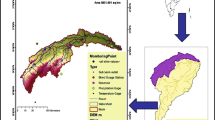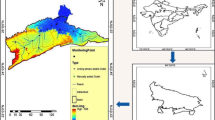Abstract
Appropriate implementation of Soil and Water Assessment Tool (SWAT) hydrologic model requires prediction uncertainty analysis, calibration and validation of the model against historical output records. Sequential Uncertainty Fitting-2 (SUFI-2) and Generalized Likelihood Uncertainty Estimation (GLUE) algorithms with ArcSWAT2009 and ArcGIS10.0 were used in this research to conduct uncertainty analysis, calibration and validation of the SWAT model using monthly observed streamflow data in Maybar experimental watershed, Ethiopia. The results revealed that the model was generally satisfactory as proved by the uncertainty, calibration and validation goodness of fit indicators: The goodness of fit and the degree to which the calibrated SWAT model accounted for the uncertainties assessed by: P-factor (72, 70 %) and (65, 69 %) for (calibration, validation) stages of SUFI-2 and GLUE algorithms, respectively, and R-factor (0.97, 0.90) and (0.89, 0.95) for (calibration, validation) stages of SUFI-2 and GLUE algorithms, respectively, are reached acceptable values, then the parameter uncertainties used were the desired parameter ranges. Further model evaluation statistics: Coefficient of Determination (R 2 ≥ 0.76), Nash–Sutcliffe efficiency (NSE ≥ 0.63), Percent Bias (PBIAS ≤ ± 7.10 %) and Root Mean Square Error-observations Standard deviation Ratio (RSR ≤ 0.46) for both calibration and validation periods were quantified and the extent of similarity between predicted and recorded streamflow data suggests that SWAT model can adequately simulate monthly streamflow at Maybar gauged watershed.













Similar content being viewed by others
References
Abbaspour KC, Johnson CA, van Genuchten MT (2004) Estimating uncertain flow and transport parameters using a sequential uncertainty fitting procedure. Vadose Zone J Hydrol 3(4):1340–1352
Abbaspour KC, Vejdani M, Haghighat S (2007) SWAT-CUP calibration and uncertainty programs for SWAT. EawagWeb. http://www.mssanz.org.au/…/24_s17/SWAT-CUP_s17_Abbaspour_.pdf. Accessed 24 March 2014
Arnold JG, Allen PM (1999) Automated methods for estimating baseflow and groundwater recharge from streamflow records. J Am Water Resour Assoc 35(2):411–424
Arnold JG, Allen PM, Muttiah R, Bernhardt G (1995a) Automated baseflow separation and recession analysis techniques. J Gr Water 33(6):1010–1018
Arnold JG, Williams JR, Maidment DR (1995b) Continuous-time on water and sediment routing model for large basins. J Hydraul Eng 121(2):171–183
Arnold JG, Srinivasan R, Muttiah RS, Williams JR (1998) Large-area hydrologic modeling and assessment: Part I Model development. J. Am Water Resour Assoc 34(1):73–89
Arnold JG, Kiniry JR, Srinivasan R, Williams JR, Haney EB, Neitsch SL (2011) Soil and Water Assessment Tool Input/Output File Documentation. Texas water Resources Institute Technical Report. Version 2009, Temple, Texas
Arnold JG, Moriasi DN, Gassman PW et al (2012) SWAT: model use, calibration, and validation. Trans Am Soc Agric Biol Eng 55(4):1491–1508
ASCE (1993) Criteria for evaluation of watershed models. J Irrig Drain Eng 119:429–442
Behulu F, Setegn S, Melesse AM, Fiori A (2012) Hydrological analysis of the Upper Tiber Basin: a watershed modeling approach. Hydrol Process 27(16):2339–2351
Behulu F, Setegn S, Melesse AM, Romano E, Fiori A (2014) Impact of climate change on the hydrology of upper Tiber River basin using bias corrected regional climate model. Water Resour Manage 28:1327–1343
Beven K (2000) Rainfall-runoff modeling: the primer. Wiley, New York
Beven K (2006) On undermining the science? Hydrol Proc 20(14):3141–3146
Beven K, Binley A (1992) The future of distributed models: model calibration and uncertainty prediction. Hydrol Process 6(3):279–298
Beven K, Freer J (2001) Equifinality, data assimilation, and uncertainty estimation in mechanistic modeling of complex environmental systems. J Hydrol 249:11–29
Bracmort KS, Arabi M, Frankenberger JR, Engel BA, Arnold JG (2006) Modeling long-term water quality impact of structural BMPS. Trans ASAE 49(2):367–384
Dessu SB, Melesse AM (2012a) Modeling the rainfall-runoff process of the Mara River Basin using SWAT. Hydrol Process 26(26):4038–4049
Dessu SB, Melesse AM (2012b) Impact and uncertainties of climate change on the Hydrology of the Mara River Basin. Hydrol Process 27(20):2973–2986
Duan Q (2003) Global Optimization for Watershed Model Calibration. In: Duan Q, Gupta HV, Sorooshian S, Rousseau AN, Turcotte R (eds) Calibration of Watershed Models. American Geophysical Union, Water Science and Application Series. Washington, DC, p 89–104
Duan Q, Sorooshian S, Gupta VK (1992) Effective and efficient global optimization for conceptual rainfall-runoff models. Water Resour Res 28(4):1015–1031
EAWAG (2013) SWAT-CUP2012: SWAT calibration and uncertainty programs—a user manual. Swiss Federal Institute of Aquatic Science and Technology
Gan TY, Dlamini EM, Biftu GF (1997) Effects of model complexity and structure, data quality, and objective functions on hydrologic modeling. J Hydrol 192(1):81–103
Gassman PW, Reyes M, Green CH, Arnold JG (2007) The Soil and Water Assessment Tool: Historical development, applications, and future directions. Trans ASABE 50(4):1211–1250
Gupta HV, Sorooshian S, Yapo PO (1998) Toward improved calibration of hydrologic models: multiple and non-commensurable measures of information. Water Resour Res 34:751–763
Gupta HV, Sorooshian S, Yapo PO (1999) Status of automatic calibration for hydrologic models: Comparison with multilevel expert calibration. J Hydrol Eng 4(2):135–143
Gupta HV, Wagener T, Liu Y (2008) Reconciling theory with observations: Elements of a diagnostic approach to model evaluation. Hydrol Proc 22(18):3802–3813
Hargreaves GL, Hargreaves GH, Rile JP (1985) Agricultural benefits for Senegal River Basin. J Irrg Drian Eng 111(2):113–124
Kuczera G, Parent E (1998) Monte Carlo assessment of parameter uncertainty in conceptual catchment models: the Metropolis algorithm. J Hydrol 211(1–4):69–85
Liu Y, Gupta HV (2007) Uncertainty in hydrologic modeling: Toward an integrated data assimilation framework. Water Resour Res. doi:10.1029/2006WR005756
McKay MD (1988) Sensitivity and Uncertainty Analysis Using a Statistical Sample of Input Values. In: Ronen Y (ed) Uncertainty Analysis, 3rd edn. CRC Press, Boca Raton, pp 145–186
Moriasi DN, Arnold JG, Van Liew MW, Binger RL, Harmel RD, Veith T (2007) Model evaluation guidelines for systematic quantification of accuracy in watershed simulations. Trans ASABE 50(3):885–900
Nash JE, Sutcliffe JV (1970) River flow forecasting through conceptual models, part I: a discussion of principles. J Hydrol 10(3):282–290
Neitsch SL, Arnold JG, Kiniry JR, Williams JR (2005) User Manual, Version 2005. Grassland Soil and Water Research Laboratory, Temple
Neitsch SL, Arnold JG, Kiniry JR, Williams JR (2011) SWAT User Manual, Version 2009. Texas Water Resources Institute. Technical Report No 406, Temple, Texas
Ning J, Gao Z, Lu Q (2015) Runoff simulation using a modified SWAT model with spatially continuous HRUs. Environ Earth Sci 74:5895–5905
Olivera F, Valenzuela M, Srinivasan R, Choi J, Cho H, Koka S, Agrawal A (2006) ArcGIS-SWAT: A geodata model and GIS interface for SWAT. J Am Water Resour Assoc 42(2):295–309
Pluntke T, Pavlik D, Bernhofer C (2014) Reducing uncertainty in hydrological modelling in a data sparse region. Environ Earth Sci 72(12):4801–4816
Sahelemedin S, Bekele T (2000) Procedures for Soil and Plant Analysis Technical Paper. Ethiopian Agricultural Research Organization, National Soil Research Center, Addis Ababa
Santhi C, Arnold JG, Williams JR, Dugas WA, Hauck L (2001) Validation of the SWAT model on a large river basin with point and nonpoint sources. J Am Water Resour Assoc 37(5):1169–1188
Schuol J, Abbaspour KC, Yang H, Srinivasan R, Zehnder AJB (2008) Modeling blue and green water availability in Africa. Water Resour Res. doi:10.1029/2007WR006609
SCRP (2000) Area of Maybar, Wollo, Ethiopia: Long-term Monitoring of the Agricultural Environment 1981–1994. Soil Erosion and Conservation Database. University of Berne, Switzerland, in association with the Ministry of Agriculture, Addis Ababa
Setegn S, Srinivasan R, Dargahi B, Melesse AM (2009a) Spatial delineation of soil erosion prone areas: application of SWAT and MCE approaches in the Lake Tana Basin. Ethiopia Hydrol Process 23(26):3738–3750
Setegn S, Srinivasan R, Melesse AM, Dargahi B (2009b) SWAT model application and prediction uncertainty analysis in the Lake Tana Basin. Ethiopia Hydrol Process 24(3):357–367
Setegn S, Dargahi B, Srinivasan R, Melesse AM (2010) Modeling of sediment yield from Anjeni gauged watershed, Ethiopia using SWAT model. JAWRA 46(3):514–526
Singh J, Knapp HV, Demissie M (2004) Hydrologic modeling of the Iroquois River watershed using HSPF and SWAT. Champaign, Illinois State Water SurveyWeb. http://www.sws.uiuc.edu/pubdoc/CR/SWSCR2004-08.pdf. Accessed 29 Jan 2014
Sloan PG, Moore ID (1984) Modeling Subsurface Streamflow on Steeply Sloping Forested watersheds. Water Resour Res 20(12):1815–1822
Srinivasan R, Zhang X, Arnold JG (2010) SWAT Ungauged: Hydrological Budget and Crop Yield Predictions in the Upper Mississippi River Basin. Trans ASABE 53(5):1533–1546
USDA-SCS (1983) National Engineering Handbook. USDA, Washington, DC
van Griensven A, Meixner T (2006) Methods to quantify and identify the sources of uncertainty for river basin water quality models. Water Sci Technol 53(1):51–59
van Griensven A, Meixner T, Srinivasan R, Grunwals S (2008) Fit-for-purpose analysis of uncertainty using split-sampling evaluations. Hydrol Sci J 53(5):1090–1103
Van Liew MW, Arnold JG, Garbrecht JD (2003) Hydrologic simulation on agricultural watersheds: Choosing between two models. Trans ASAE 46(6):1539–1551
Van Liew MW, Arnold JG, Bosch DD (2005) Problems and potential of auto-calibrating a hydrologic model. Trans ASAE 48(3):1025–1040
Vrugt JA, Gupta HV, Bouten W, Sorooshian S (2003) A shuffled complex evolution metropolis algorithm for optimization and uncertainty assessment of hydrologic model parameters. Water Resour Res. doi:10.1029/2002WR001642
Wagener T, Sivapalan M, McDonnell JJ, Hooper R, Lakshmi V, Liang X, Kumar P (2004) Predictions in ungauged basins (PUB): A catalyst for multi-disciplinary hydrology. Eos Trans AGU 85(44):451–452
Wang X, Melesse AM (2005) Evaluations of the SWAT model’s snowmelt hydrology in a Northwestern Minnesota watershed. Trans ASAE 48(4):1359–1376
Wang X, Melesse AM, Yang W (2006a) Influences of potential evapotranspiration estimation methods on SWAT’s hydrologic simulation in a Northwestern Minnesota watershed. Trans ASAE 49(6):1755–1771
Wang X, Melesse AM, Yang W (2006b) Effects of STATSGO and SSURGO as inputs on SWAT Model’s snowmelt simulation. J Am Water Resour Assoc 42(5):1217–1236
Wang X, Shang S, Yang W, Melesse AM (2008a) Simulation of an agricultural watershed using an improved curve number method in SWAT. Tans Am Soc Agri Bio Eng 51(4):1323–1339
Wang X, Yang W, Melesse AM (2008b) Using hydrologic equivalent wetland concept within SWAT to estimate streamflow in watersheds with numerous wetlands. Tans Am Soc Agri Bio Eng 51(1):55–72
Weigel G (1986) The soils of the Maybar Area, Wollo Research unit, Ethiopia. SCRP, Research Report 7. University of Berne, Switzerland, in association with the United Nations University, Tokyo
Williams JR (1969) Flood routing with variable travel time or variable storage coefficients. Trans ASAE 12(1):100–103
Yang J, Reichert P, Abbaspour KC, Xia J, Yang H (2008) Comparing uncertainty analysis techniques for a SWAT application to the Chaohe Basin in China. J Hydrol. doi:10.1016/j.jhydrol.2008.05.012
Yesuf HM, Assen M, Alamirew T, Melesse AM (2015) Modeling of sediment yield in Maybar gauged watershed using SWAT, Northeast Ethiopia. CATENA 127:191–205. doi:10.1016/j.catena.2014.12.032
Zhang X, Srinivasan R, Van Liew MW (2008) Multi-site calibration of the SWAT model for hydrologic modeling. Trans ASABE 51(6):2039–2049
Acknowledgments
The authors are grateful to Wollo University and National Center of Competence in Research (NCCR) North–South for sponsoring this project. We sincerely appreciate Ali Ahmed’s priceless backing offered to us during fieldwork in the study area.
Author information
Authors and Affiliations
Corresponding author
Rights and permissions
About this article
Cite this article
Yesuf, H.M., Melesse, A.M., Zeleke, G. et al. Streamflow prediction uncertainty analysis and verification of SWAT model in a tropical watershed. Environ Earth Sci 75, 806 (2016). https://doi.org/10.1007/s12665-016-5636-z
Received:
Accepted:
Published:
DOI: https://doi.org/10.1007/s12665-016-5636-z




